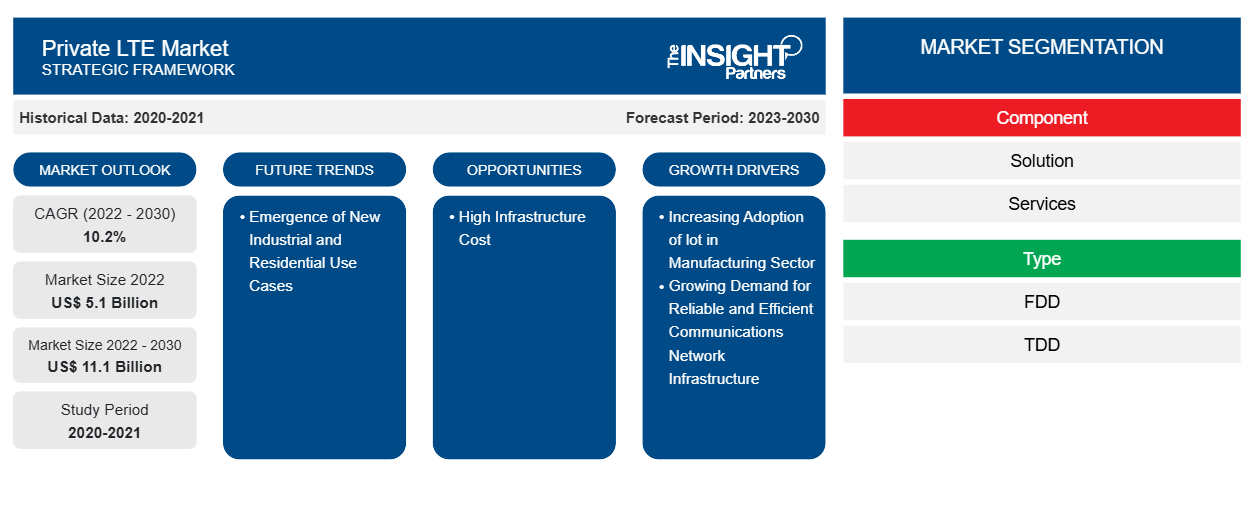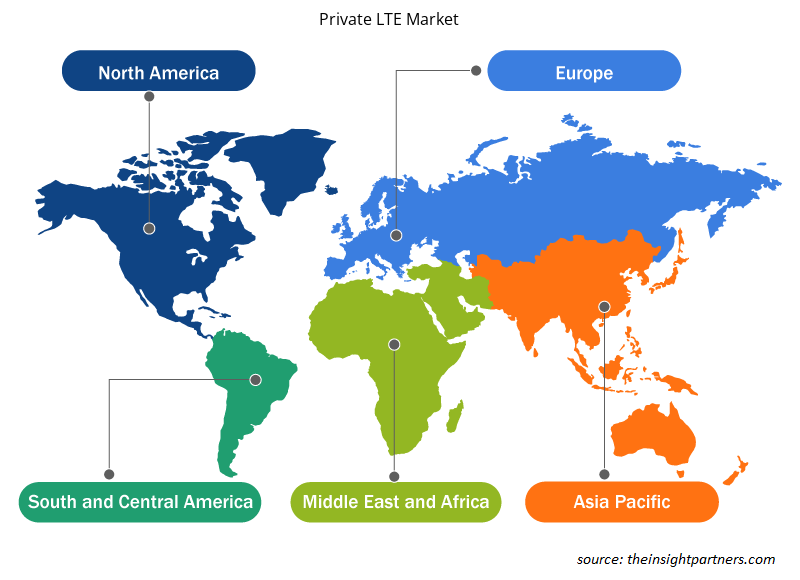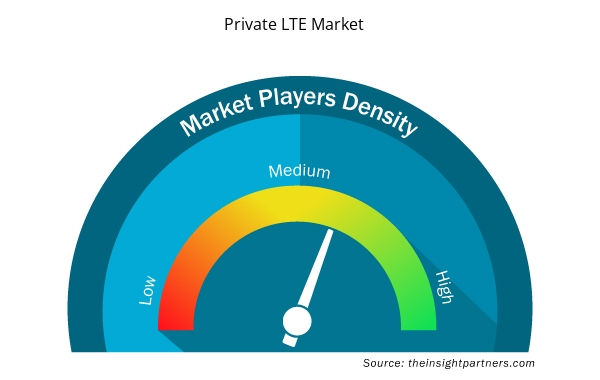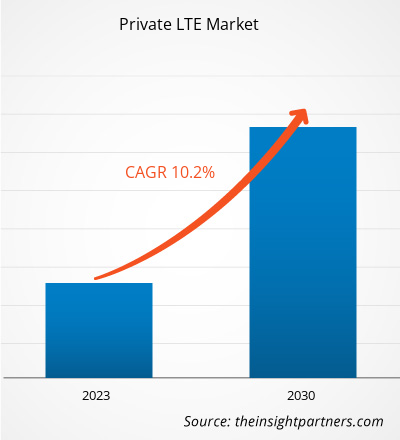[Research Report] The private LTE market size was valued at US$ 5.1 billion in 2022 and is expected to reach US$ 11.1 billion by 2030. The private LTE market is estimated to record a CAGR of 10.2% from 2022 to 2030.
Analyst Perspective:
The private LTE market is segmented into five major regions: North America, Europe, APAC, MEA, and SAM. Among these regions, North America is expected to dominate the global private LTE market during the forecast period, owing to the rising adoption of LTE networks and the growing need to support low latency networks for mission-critical communications and industrial IoT services. The private LTE market in Europe is expected to propel during the forecast period because the majority of public safety agencies in countries such as Norway, Poland, and Finland rely on TETRA networks for emergency service communications, which, in turn, require integration with advanced wireless solutions, such as broadband and LTE, to improve network capabilities. APAC is expected to offer new market opportunities for vendors of private LTE networks. Considering the APAC private LTE market growth, Japan, China, and Australia are among the vital countries. China and Japan are the most significant manufacturing economies producing automobiles, IT, and electronic products. The private LTE market growth in this region is due to the rise in M2M communications and the increase in smartphone penetration, supported by the penetration of IoT platforms across industries such as healthcare, transportation, and manufacturing. This leads to the increased demand for private IoT networks, which enable companies to integrate different devices for increased reliability and security.
Furthermore, the private LTE market is experiencing significant growth in the Middle East & Africa (MEA) and South America. Governments in these regions are investing heavily in smart cities, transportation, and energy infrastructure, all of which benefit from the secure and reliable connectivity of private LTE networks. In the MEA, industries such as oil & gas, mining, and manufacturing are increasingly adopting automation, requiring dedicated networks for critical communications and data transfer. Additionally, public safety agencies recognize private LTE's advantages for improving communication and emergency response capabilities.
Private LTE Market Overview:
A private LTE network is designed to develop reliable connectivity in a specific company. Private LTE networks offer a variety of features, such as high speed, high capacity, high safety, low latency, consistent performance, more comprehensive range, and interoperability, complementing the demand for IIoT. A private LTE network allows low network site latency and direct access to network devices, such as sensors, gateways, smartphones, and even autonomous vehicles. By linking all these systems over a single network, companies can handle their activities and connectivity more effectively. In addition, the increasing adoption of smartphones globally is expected to push market expansion in a positive direction during the forecast period. Furthermore, government initiatives to improve public safety are projected to fuel the global demand for private LTE networks. However, problems such as the complexity of implementing a private LTE network might hamper the growth of the private LTE market during the forecast period.
The growing requirement for transitioning disparate, disconnected networks to innovative connected systems to offer enhanced customer interaction and service delivery modes has led to the introduction of private LTE networks. Furthermore, a private LTE network eradicates the constraints linked with a conventional network system, such as Ethernet or Wi-Fi, by supporting human and machine communication on one network. Private LTE network, still in its stage of development, is comparatively niche and, in the past four years, has not seen much penetration. However, with the introduction of the Industrial Internet of Things (IIoT), its deployment is expected to witness high growth opportunities.
Customize This Report To Suit Your Requirement
You will get customization on any report - free of charge - including parts of this report, or country-level analysis, Excel Data pack, as well as avail great offers and discounts for start-ups & universities
Private LTE Market: Strategic Insights

- Get Top Key Market Trends of this report.This FREE sample will include data analysis, ranging from market trends to estimates and forecasts.
Customize This Report To Suit Your Requirement
You will get customization on any report - free of charge - including parts of this report, or country-level analysis, Excel Data pack, as well as avail great offers and discounts for start-ups & universities
Private LTE Market: Strategic Insights

- Get Top Key Market Trends of this report.This FREE sample will include data analysis, ranging from market trends to estimates and forecasts.
Private LTE Market Driver:
Increasing Adoption of IoT in Manufacturing Sector Drives Private LTE Market Growth
The increasing adoption of Industry 4.0, industrial IoT, and automated technology is significantly fueling the demand for private LTE. The continuous advancements in connectivity are the key parameters positively influencing the market growth. The increasing number of connected devices in the manufacturing sector is generating massive amounts of data, which needs to be analyzed effectively for smooth business operations. The rise in investments in machine-to-machine (M2M) and traditional IoT has enabled a significant increase in the economies of scale that drive the adoption of private LTE across the sector.
Private LTE service providers highly focus on offering personal LTE services for the manufacturing sector worldwide. The market is witnessing various initiatives for the development of advanced private LTE solutions for the manufacturing sector. For instance, in February 2020, Nokia partnered with Bharti Airtel to offer private LTE and industrial AI to enterprises in the distribution and manufacturing sectors. This partnership is expected to drive a new level of automated data exchange and improve operational efficiencies at low costs. Thus, the increasing adoption of IoT in the manufacturing sector is a potential driver for the private LTE market.
Private LTE Market Report Segmentation and Scope:
The global private LTE market is segmented based on component, type, end user, and geography. Based on component, the private LTE market is segmented into solutions and services. In terms of type, the private LTE market is segmented into FDD and TDD. Based on end-user, the market is segmented into manufacturing, energy & utilities, healthcare, transportation, mining, and others. In terms of geography, the global market is segmented into five major regions: North America, Europe, Asia Pacific (APAC), Middle East & Africa (MEA), and South America (SAM).
Private LTE Market Segmental Analysis:
Based on component, the private LTE market is bifurcated into solution and services. The solution segment held the largest private LTE market share in 2022. The private LTE components include various hardware and software solutions. Hardware devices associated with the private LTE network include devices for control and management, Ethernet switches, and network access points. Vendors offer different software and platforms for applications, such as LTE access point management. LTE AP management provides a user-friendly interface to configure and manage private LTE access points. It is a robust cloud-based platform for day-to-day operations and monitoring of private LTE networks. Vendors offer various cloud-based software updates for these LTE devices.
Private LTE Market Regional Analysis:
The Asia Pacific private LTE market is expected to register the highest CAGR during the forecast period 2023-2030. The Asia Pacific private LTE market is segmented into Australia, China, India, Japan, South Korea, and the Rest of Asia Pacific.
APAC is constantly witnessing a growing economy, leading to growth in various sectors, including manufacturing, infrastructure, and technology. Many of the region's economies are focusing on autonomous vehicles, smart cities, and IoT to empower their economy further. The investors avoid high-tech costs investment in the US. They are diverting toward APAC to invest in significant business opportunities, which include the growth of LTE technology with the acceleration in the adoption of digital transformation across various countries in the region. The APAC private LTE market is segmented into South Korea, India, China, Japan, Australia, and the Rest of APAC.
The massive populations of China and India, the increasing middle-class population in these countries, and the growing telecom sector in both countries are projected to grow due to the deployment of LTE. The advancement in mobile technology and connected infrastructure across China, Japan, and South Korea will further boost the demand for private LTE. Moreover, the growing smartphone penetration in APAC is a significant factor driving the private LTE market across the region. The development of LTE networks and the accessibility of low-cost Android smartphones boost the demand for private LTE networks to engage more users. Furthermore, China is the largest producer of passenger cars globally; India, Japan, and South Korea are some of the primary vehicle manufacturing countries. The region is the third-largest pharmaceutical producer after North America and Europe. The supportive Government and favorable initiatives in many Asian countries, such as the price reform in Japan and China, the Food and Drug Administration's reform in China, supportive funding in Southeast Asia, and growing digitalization in the pharmaceutical industry are the major factors driving the private LTE market in the region.
Private LTE Market Key Player Analysis:
Cisco Systems, Inc.; ERICSSON; Huawei Technologies Co., Ltd; Samsung; VERIZON COMMUNICATIONS, INC; CommScope Inc.; Future Technologies, Inc.; NetNumber, Inc.; Star Solutions; and Sierra Wireless, Inc. are among the key companies operating in the private LTE market.
Private LTE Market Regional Insights
Private LTE Market Regional Insights
The regional trends and factors influencing the Private LTE Market throughout the forecast period have been thoroughly explained by the analysts at Insight Partners. This section also discusses Private LTE Market segments and geography across North America, Europe, Asia Pacific, Middle East and Africa, and South and Central America.

- Get the Regional Specific Data for Private LTE Market
Private LTE Market Report Scope
| Report Attribute | Details |
|---|---|
| Market size in 2022 | US$ 5.1 Billion |
| Market Size by 2030 | US$ 11.1 Billion |
| Global CAGR (2022 - 2030) | 10.2% |
| Historical Data | 2020-2021 |
| Forecast period | 2023-2030 |
| Segments Covered |
By Component
|
| Regions and Countries Covered | North America
|
| Market leaders and key company profiles |
Private LTE Market Players Density: Understanding Its Impact on Business Dynamics
The Private LTE Market market is growing rapidly, driven by increasing end-user demand due to factors such as evolving consumer preferences, technological advancements, and greater awareness of the product's benefits. As demand rises, businesses are expanding their offerings, innovating to meet consumer needs, and capitalizing on emerging trends, which further fuels market growth.
Market players density refers to the distribution of firms or companies operating within a particular market or industry. It indicates how many competitors (market players) are present in a given market space relative to its size or total market value.
Major Companies operating in the Private LTE Market are:
- Cisco Systems Inc.
- Telefonaktiebolaget LM Ericsson
- Huawei Investment & Holding Co Ltd
- Samsung Group
- Verizon Communications Inc
Disclaimer: The companies listed above are not ranked in any particular order.

- Get the Private LTE Market top key players overview
Private LTE Market Recent Developments:
Inorganic and organic strategies such as mergers and acquisitions are highly adopted by companies in the private LTE market. A few recent key private LTE market developments are listed below:
- In November 2023, the Port of Tyne, together with partners B.T. and Ericsson, deployed a private network with coverage across the entire estate, making it the UKs first site-wide deployment of 4G and 5G standalone connectivity for smart port applications. The infrastructure is built upon an Ericsson Private 5G solution and B.T. spectrum, where both 4G and 5G will operate simultaneously to support legacy devices and power new 5G applications in the Port's future transformation.
- In March 2023, Huawei revealed a fresh project involving Private Networks at M.W.C. 2023. The Huawei Private Network Alliance, a new initiative from the business, intended to unite top players in the private network industry. The association gave members a forum to exchange knowledge and resources, enabling them to work together on creating fresh Private Network-related products and services.
- In February 2022, Samsung Electronics America and Amdocs, a leading provider of software and services to communications and media companies, collaborated to deliver end-to-end 4G and 5G private network solutions to US enterprises to help businesses across key industries leverage next-generation communications applications and services.
- Historical Analysis (2 Years), Base Year, Forecast (7 Years) with CAGR
- PEST and SWOT Analysis
- Market Size Value / Volume - Global, Regional, Country
- Industry and Competitive Landscape
- Excel Dataset



Report Coverage
Revenue forecast, Company Analysis, Industry landscape, Growth factors, and Trends

Segment Covered
Component, Type, and End-User

Regional Scope
North America, Europe, Asia Pacific, Middle East & Africa, South & Central America

Country Scope
This text is related
to country scope.
Frequently Asked Questions
Increasing adoption of IoT in manufacturing sector and the growing demand for reliable and efficient communications network infrastructure are the major factors that propel the global private LTE market.
The global private LTE market was estimated to be US$ 5.1 billion in 2022 and is expected to grow at a CAGR of 10.2% during the forecast period 2023 - 2030.
The key players holding majority shares in the global private LTE market are Cisco Systems Inc., Telefonaktiebolaget LM Ericsson, Huawei Investment & Holding Co Ltd, Samsung Group, Verizon Communications Inc, CommScope Holding Co Inc, Future Technologies, Inc., Star Solutions, Sierra Wireless, Inc., Kyndryl Holdings Inc.
Emergence of new industrial and residential use cases is anticipated to play a significant role in the private LTE market in the coming years.
The global battery market is expected to reach US$ 11.1 billion by 2030.
The incremental growth expected to be recorded for the private LTE market during the forecast period is US$ 5.9 billion.
Trends and growth analysis reports related to Technology, Media and Telecommunications : READ MORE..
The List of Companies - Private LTE Market
- Cisco Systems Inc.
- Telefonaktiebolaget LM Ericsson
- Huawei Investment & Holding Co Ltd
- Samsung Group
- Verizon Communications Inc
- CommScope Holding Co Inc
- Future Technologies, Inc.
- Star Solutions
- Sierra Wireless, Inc.
- Kyndryl Holdings Inc

 Get Free Sample For
Get Free Sample For